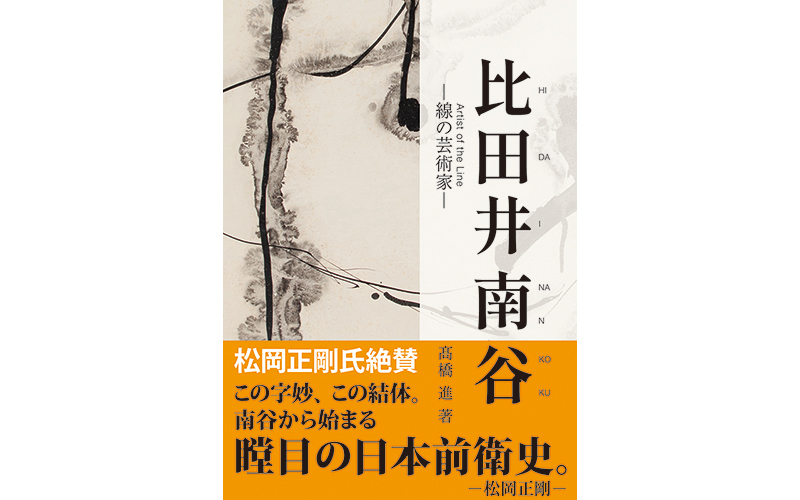Tenraishoin published a new book, “HIDAI NANKOKU-- Artist of the Line---" by Takahashi Susumu.

Nankoku's Path: Pioneering Avant-Garde calligraphy without writing characters!
In Japan after the defeat in World War II, calligrapher Hidai Nankoku (1912-1999) created the first " calligraphy without writing characters" in the history of calligraphy. Nankoku maintained the belief that the artistic value of calligraphy was independent of its literary contents, and that the true essence of calligraphy lay in the rich expressiveness of its lines. He continued to experiment in isolation throughout his life, and these experiments led to constant transformations in his work. This book traces the trajectory of Nankoku's experiments as an "Artist of the line," and includes images and unpublished materials of many of his works, as well as summaries in English and a detailed chronology.
This book is composed of four parts:
Part 1: The creation of "Art of the Line", Part 2: Verification of the Universality of Art of the Line, Part 3: Art of the Line that shocked the world, and Part 4: Further Possibilities of Art of the Line.
Until now, there has been little clarification or understanding of Nankoku's artistic activities and his Art of the Line, but the book examines the birth of Nankoku's "Shinsen(Spirit Line) works" and his activities in the art world of America and Europe, as well as the possibilities of Nankoku's Art of the Line. In publishing this book, we make use of the vast number of materials left by Nankoku, and also introduce the trends of calligraphers and artists of the same era, in an attempt to elucidate the uniqueness of Nankoku's " Art of the Line".
A part of this book is introduced to translate into English.
Nankoku perceived the establishment of artistic quality in calligraphy as awareness and independence of the aesthetic expressiveness of the lines, and he attempted to break away from the constraints of characters (sentences) and to extract Hitsui (aesthetic expressiveness) expressed by lines in the history of classical calligraphy, and to create their original expressions. (The Book, p.51)
"The Act of Writing"
Like Western avant-garde art, the collapse of contemporary traditional culture led calligraphy to break free from the shackles of tradition and to be reborn itself with the aim of free artistic creation. To do so, calligraphers were forced to free themselves from the constraints of the fixed idea that calligraphy was to write characters and literary contents, which they had become habitually unaware of, and to consciously and reflectively consider the essential elements of calligraphy, such as "characters, brush, ink, paper" and "the writing selfhood, the writing body, and the writing contents." (ibid, p.129)
When doing so, the emphasis on the physicality of the act of writing (the act and manner of writing) while purifying the formative qualities of the characters became the point that resembles Abstract Expressionism in the West. However, Nankoku argues that the emphasis on the physicality should not be a spontaneous, unconscious expression of the act of "writing", but that "writing" is about "writing" over the course of one time passage, looking at one dot or one line with your eyes, handling it with your hands, consciously measuring the expressive power of the line's curvature and twist, its speed and gentleness, its shading and strength, while feeling the breathing and pulse of your own body. (ibid.)
"The Art of the Human Hidai Nankoku"
Nankoku does not disagree that the history of calligraphy, which spans over 3,000 years, has always used characters as materials in calligraphy. As his father Tenrai had argued, he was convinced that calligraphy was established as a form of art, independent of documents that convey meaning with symbolization, based on the elements of Hitsui and the beauty of the composition (Hitsui=the expressiveness of lines, composition = the expressiveness of the connections of lines that make up characters).
Resisting the idea that calligraphic lines are bound by the established rules (codes) of characters that convey meaning and are subordinated to them, he continued to strive to prove that for the purpose of achieving the expressiveness of calligraphic lines, it is possible to move away from characters and write calligraphy without writing characters, without necessarily being bound by them.
The aim of calligraphy as Art was to bring about new, layered resonances in the minds of viewers that were inexperienced but seemed to well up from the depths of their memories, through the beauty of lines, the strength of lines, the delicacy of lines, the resonance that lines conveyed, and the symphonic sounds through correspondence between the lines and the space. The aim was to create a space where the calligrapher's humanity could be felt from the movement of the lines, and where the spirit of the lines would resonate in the spirit of the viewer, through creating a space where both could resonate together. (ibid, p.163)